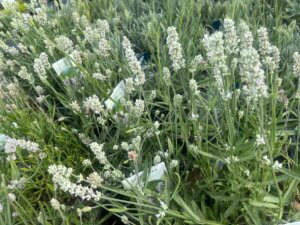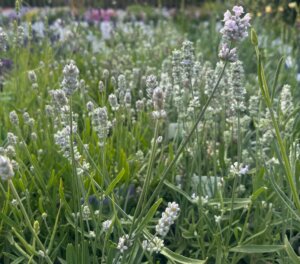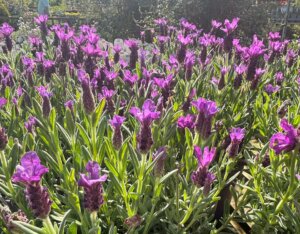Lavender (Lavandula) is popular among gardeners and herbal enthusiasts alike with its soothing scent, striking purple flowers, and medicinal properties. People grow lavender not only for its beauty, but also to attract pollinators, brew natural remedies and create calming home fragrances. Whether you’re starting a garden or expanding your herbal collection, lavender brings timeless charm and practical benefits to every outdoor space.
Our hardy plant manager Paul says ‘Lavender is extremely rewarding when planted in a sunny spot. It’s soothing and calming properties make it a great candidate for a sensory garden. Learn more about sensory gardens here!
Did you know? There are over 45 species of lavender!
While most people recognise English lavender (Lavandula angustifolia), the genus includes over 450 varieties with unique scents, colours and growth habits!
Growing Lavender in the UK
Lavender grows beautifully in the UK, especially in sunny, well-drained spots. Hardy varieties like English lavender can handle the British weather well, even in the colder regions. Lavender is perfect for raised beds, borders, or pots. Once established, it’s low maintenance, drought tolerant and a magnet for bees & pollinators!
Climate & Hardiness
Lavender prefers a Mediterranean style climate – warm, sunny and dry! However, many varieties, especially English lavender (Lavandula angustifolia) thrive in the UK’s temperate conditions. It’s generally hardy down to around -15c, depending on the variety and drainage. Cold isn’t necessarily a problem, but excess moisture is. To keep plants healthy, ensure good air circulation and excellent drainage, especially in wetter regions. In colder parts of the UK, consider growing lavender in pots so it can be easily moved in the event of adverse weather.
Soil Requirements
Lavender thrives in light, well-drained soil with a neutral pH. It dislikes heavy, clay or waterlogged soils, which can lead to root rot especially in winter. To improve drainage, amend soil with grit, sand, or well-rotted organic matter before planting. Overly rich or fertilised soil can cause leggy growth and reduce the concentration of oils in the leaves and flowers.
Is Lavender easy to grow?
Yes, lavender is easy to grow, especially once established. It thrives with minimal care, providing you meet its basic needs: full sun, well-drained soil & not too much water. It’s drought tolerant, pest resistant and doesn’t require regular feeding.
Propagation
You can propagate lavender easily through multiple methods; however, cuttings are the most reliable and fastest method for gardeners.
- Softwood Cuttings: In spring to late summer, take 7-10cm non-flowering shoots from healthy plants. Strip the lower leaves and insert the cuttings into gritty well-draining compost.
- Semi-ripe Cuttings: In late summer, use firmer mature stems from the current season’s growth. Follow the same process as softwood cuttings, but expect slower progress.
- Layering: Bend a low-growing stem to the ground, nick it slightly, and bury it in the soil while keeping the tip exposed. Once rooted, cut & transplant.
- Seeds: Sow lavender seeds indoors in early spring.
Planting
Choose a sunny, sheltered spot with well-drained soil. Dig a hole just deep enough to fit the root ball and space plants 30-45cm apart. If your soil is heavy, improve drainage by mixing in horticultural grit. Prune yearly to keep the plant compact & avoid overwatering.
Winter Care
Lavender is hardy but needs protection from wet, cold conditions during winter. Ensure excellent drainage to aovid waterlogged soil in the event of a wetter winter. In colder or wetter areas, consider covering plants with horticultural fleece or moving potted lavender to a sheltered, frost-free spot.
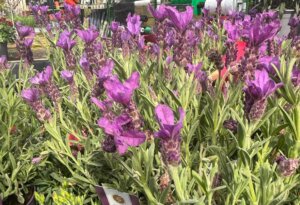
Pruning & Harvesting
Prune lavender annually to keep it healthy and encourage bushy growth. Tip from Greenhouse Manager Clayre: ‘Lavender can create lovely stretches of hedges, but cut back in the Autumn so it doesn’t become too woody!’ The best time to prune is just after flowering, usually late summer or early autumn. Cut back about one-third of the plants, trimming spent flower stems and shaping the foliage, but avoid cutting into old wood.
Harvest lavender flowers when the buds are fully formed but before they open for the best scent and colour. Cut flower stems early in the morning & regularly harvest to encourage new growth and prolong the blooming season
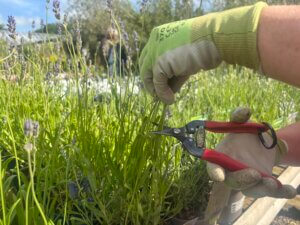
Storage
To preserve lavender’s fragrance and colour, you can store it fresh, dried, or frozen
- Fresh: Keep lavender stems in a vase with water like cut flowers for a few days
- Dried: Tie small bunches together and hang them upside down in a warm, dark, and well-ventilated place. Once dry, strip the flowers from the stems and store them in a container away from direct sunlight
- Frozen: Spread lavender flowers on a baking sheet and freeze them. Once frozen, transfer to containers for long-term storage
Lavender is a beautiful, fragrant herb that thrives in sunny, well-drained spots and adds charm to any garden or container. Its soothing scent attracts pollinators and promotes wellness, while its low-maintenance nature makes it perfect for gardeners of all levels.
Come visit us to pick your perfect lavender plant and start growing this timeless favourite today!

